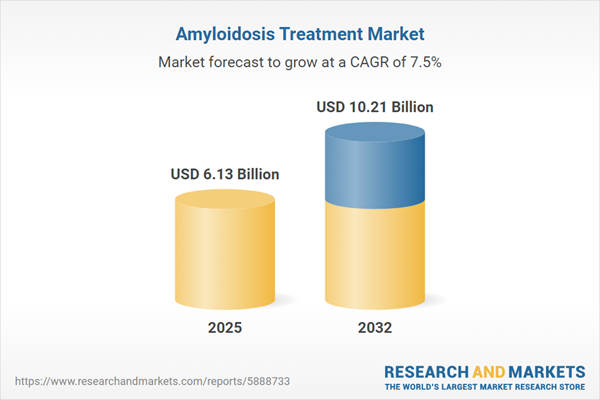Speak directly to the analyst to clarify any post sales queries you may have.
The amyloidosis treatment market is evolving, presenting new challenges and opportunities for senior leaders aiming to build resilient strategies in a shifting regulatory and therapeutic landscape.
Amyloidosis Treatment Market Snapshot
Marked by increased disease awareness and the development of novel therapies, the amyloidosis treatment market has achieved robust growth and heightened competition. Both established pharmaceutical organizations and emerging players are investing in targeted research and innovation to secure market leadership. Patient-centric care approaches are gaining traction, which has led to diversified treatment offerings and the adoption of adaptive operating models. Distinct regulatory frameworks and infrastructure disparities across the Americas, EMEA, and Asia-Pacific are prompting executive teams to refine resource allocation and accelerate responsiveness to dynamic clinical and commercial demands.
Scope & Segmentation of the Amyloidosis Treatment Market
This report delivers comprehensive segmentation and actionable insights to help business leaders make informed investment and operational decisions in the amyloidosis treatment market, reflecting ongoing clinical, commercial, and regulatory shifts:
- Treatment Types: Pharmacological therapies, stem cell transplantation, and supportive care solutions each impact clinical priorities and inform care delivery frameworks.
- Routes of Administration: Intravenous, oral, and subcutaneous formulations directly influence patient access, adherence, and distribution logistics.
- End User Settings: Home care, hospital-based care, and specialty clinics shape patient management protocols and determine resource planning needs.
- Drug Classes: Alkylating agents, immunomodulators, monoclonal antibodies, proteasome inhibitors, and TTR silencers and stabilizers guide R&D direction and investment choices.
- Amyloidosis Types: AA, AL, hereditary ATTR, and wild-type ATTR segmentation enables tailored communication, research, and positioning efforts.
- Geographies: Regional reporting spans the Americas, EMEA, and Asia-Pacific, emphasizing primary markets such as the US and Canada and identifying emerging opportunities for growth.
- Notable Companies: Pfizer Inc., Alnylam Pharmaceuticals, Johnson & Johnson (Janssen Biotech), Ionis Pharmaceuticals, BridgeBio Pharma, and Prothena Corporation are profiled for benchmarking and partnership assessment.
Amyloidosis Treatment Market: Key Strategic Takeaways
- Prioritizing targeted therapies supports patient-centered models and operational efficiency in therapeutic delivery.
- Deploying TTR silencers and monoclonal antibodies requires flexible budgets and processes to support effective market introduction and scale.
- Integrating digital health solutions, including telemonitoring, enhances clinical coordination, diagnostic precision, and ongoing patient engagement.
- Collaboration with both industry and academic partners accelerates innovation cycles, reduces development timelines, and improves regulatory adaptability.
- Tailoring reimbursement strategies to diverse policy landscapes safeguards therapy access and ensures sustainable market operations.
- Emphasizing oral therapy development enables organizations to quickly adjust to evolving care models and optimize cost structures.
Tariff Impact on Supply Chains and Access
Recent U.S. tariff adjustments have increased raw material costs, intensifying pressures on amyloidosis treatment supply chains. To respond effectively, organizations are enhancing domestic sourcing strategies and streamlining manufacturing to maintain stable patient access during shifts in demand and logistics. These measures often lead to new agreements with payers and the adoption of variable pricing structures. Smaller firms are managing volatility by focusing on oral therapy innovation and forming international alliances to strengthen regulatory compliance and competitive resilience.
Methodology & Data Sources
The findings in this report are based on rigorous analysis of peer-reviewed systematic reviews, clinical trial data, relevant regulatory documents, and direct expert input. All recommendations are validated to ensure relevance and practicality for senior executives guiding organizational strategy.
Why This Report Matters
- Supports executive planning by offering detailed market segmentation and competitive analytics for amyloidosis treatment solutions.
- Enables organizations to integrate new therapies, navigate complex regulatory environments, and optimize investment decisions to improve clinical results.
- Provides operational frameworks for overcoming logistical challenges, building key alliances, and maintaining robust pipelines in diverse global markets.
Conclusion
This report equips executive teams with clear, actionable insights to proactively address regulatory and therapeutic changes, ensuring strategies remain strong and adaptive in the evolving amyloidosis treatment market.
Additional Product Information:
- Purchase of this report includes 1 year online access with quarterly updates.
- This report can be updated on request. Please contact our Customer Experience team using the Ask a Question widget on our website.
Table of Contents
3. Executive Summary
4. Market Overview
7. Cumulative Impact of Artificial Intelligence 2025
Companies Mentioned
The companies profiled in this Amyloidosis Treatment market report include:- Pfizer Inc.
- Alnylam Pharmaceuticals, Inc.
- Johnson & Johnson (Janssen Biotech, Inc.)
- Ionis Pharmaceuticals, Inc.
- BridgeBio Pharma, Inc.
- Prothena Corporation plc
Table Information
| Report Attribute | Details |
|---|---|
| No. of Pages | 188 |
| Published | October 2025 |
| Forecast Period | 2025 - 2032 |
| Estimated Market Value ( USD | $ 6.13 Billion |
| Forecasted Market Value ( USD | $ 10.21 Billion |
| Compound Annual Growth Rate | 7.5% |
| Regions Covered | Global |
| No. of Companies Mentioned | 7 |









